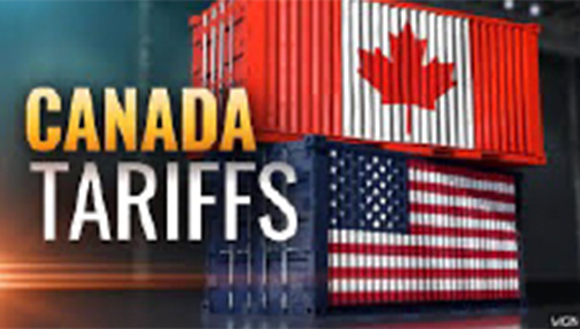Trump Reverses Tariffs That Caused Market Meltdown, but Companies Remain Bewildered
U.S. President Donald Trump has reverted on his trade policy, suspending for 90 days import taxes he imposed on dozens of countries while escalating his trade war with China. This move triggered a powerful stock market rally on Wall Street but left businesses, investors, and America’s trading partners bewildered about what the president is attempting to achieve.
The sudden change in policy came after the sweeping global tariffs Trump announced set off a four-day rout in global financial markets, paralyzed businesses, and raised fears that the U.S. and world economies would tumble into recession.
White House press secretary Karoline Leavitt tried to characterize the sudden change in policy as part of a grand negotiating strategy. However, those outside the Trump administration saw it as a cave-in to market pressure and growing fears that the president’s impetuous use of import taxes — tariffs — would cause massive collateral economic damage.
Daniel Russel, vice president at the Asia Society Policy Institute, said that the administration’s blunt-force tactics have rattled allies, who see the sudden reversal as damage control following the market meltdown rather than a pivot to respectful, balanced negotiations.
Trump’s ever-changing trade war tactics, including earlier levies on cars, steel, aluminum, Mexico, and Canada, have already done damage, forcing dazed companies to delay or cancel plans as they tried to figure out what Trump was doing and how they should respond. Some companies temporarily laid off workers after Trump’s widespread tariffs were announced, while there were signs that many firms held off on hiring amid the widespread uncertainty the tariffs created.
The World Trade Organization’s director-general, Ngozi Okonjo-Iweala, warned that the rising tension could reduce U.S.-China merchandise trade by 80 percent and “severely damage the global economic outlook.” She warned that the negative effects could ripple through to other economies, especially developing ones. She urged countries to ensure an open global trading system and resolve differences through cooperation.
U.S. companies struggled to figure out how to respond to huge levies on Chinese products they’d come to rely on. Jessica Bettencourt, CEO of Klem’s, a third-generation store in Spencer, Massachusetts, that sells everything from lawn and garden items to workwear and gifts, said that the escalation of tariffs from China has made her stop ordering any new fourth-quarter product that is holiday, gifts, or toys. She is also reconsidering any fall apparel and footwear orders that aren’t already placed.
“The worst thing is uncertainty, and we have massive uncertainty,” said Jason Goldberg, chief commerce strategy officer at Publicis Groupe, a global marketing and communications company. “No one can make any moves. Everybody is trying to save as much cash and defer any unnecessary expense. People are getting laid off. Orders are getting canceled. Expansion plans are being put on hold.”
Source: CTV News
The World Order of the Last Few Decades May Be Over — What Emerges Could Include China
As the world order is reshaped by US President Donald Trump’s tariffs and trade war with China, there are concerns about whether the world order has collapsed or which countries could emerge as new leaders. Cameron Johnson, a senior partner with Shanghai-based supply chain consultancy Tidalwave Solutions, believes that the world order of the last 80 years as we know it is dead. As countries grapple with their responses to Trump’s sweeping tariffs, some analysts suggest the world may have no choice but to look toward Asia to bolster trade and cooperation, especially as the US regime appears increasingly unpredictable.
On April 2, Trump imposed a blanket 10% tariff rate on nearly every country, with many getting hit harder. China was one of them, at 34%. This move set off a full-on tit-for-tat with Beijing that has rapidly ramped up. Despite many countries attempting to negotiate with Trump, there are no indications of an end in sight, at least to the unpredictability.
China is currently facing a 112.5% tariff rate, with a Chinese foreign ministry spokesperson vowing the country will “fight to the end” if the US doesn’t back down. On April 9th, China’s tariff rate for U.S. imports was 84%, and it also placed export restrictions on rare earth elements critical to electric vehicles, weapons, and computer chips.
China has made inroads into several continents, positioning itself as a country with which others can do business and trade, most notably with its massive Belt and Road Initiative. The reshaping of the world order began long before Trump’s second term, with China becoming Africa’s largest trading partner in the last 20 years and the largest trading partner of the Association of Southeast Asian Nations (ASEAN) countries since 2009.
The US has shifted to focusing on investment in its own country, like autos, rather than expanding its overseas markets. Countries seeking investment and technology could be forced to turn to China, as it is a tech leader and the world’s second-largest economy. Emotionally, countries affected by US tariffs could look for other options, with China as the long-term winner. Asian countries, including China, South Korea, and Japan, could benefit from this.
Despite frosty relations, China and European countries could also grow closer as the drama unfolds. Chinese Premier Li Qiang and European Commission President Ursula von der Leyen held a phone call on Tuesday, stressing the importance of maintaining continuity and stability of EU-China relations. Negotiations are set to resume on the EU’s tariffs on Chinese-made electric vehicles, imposed last fall. British Energy Secretary Ed Miliband visited China in March for the first formal climate meeting in almost a decade.
Canada’s Prime Minister Mark Carney has been focusing on a low-risk strategy to strengthen ties with China, according to Gregory Chin, an associate political economy professor at York University in Toronto. However, Carney is wary of China’s ambassador to Ottawa discussing boosting trade ties, stating that there are partners in Asia that we can build deeper ties with, but that doesn’t necessarily mean including China.
As the dust settles, many analysts believe the U.S.-China relationship is “beyond salvation,” with a chance for a full breakdown, potentially allowing China to play an even bigger role in the world. The West may have no choice but to accept this.
Source: CBC
Canada May Yet Thrive in Donald Trump’s World Trade War
US President Donald Trump has launched an unprecedented tariff war against over 180 countries. This strategy has some merit for Canada from a competitive dynamics perspective. Competitive dynamics research shows that countries that initiate aggressive moves often secure a decisive advantage, particularly when competitors hesitate or fail to respond promptly. The likelihood of competitors retaliating depends heavily on critical factors, such as the relative power between the aggressor and the targeted country, the extent of multilateral competition among targeted rivals, and the degree of familiarity between the aggressor and its targets.
Applying competitive dynamics logic to global trade allows some bold predictions about the trajectory of this current trade war. Mr. Trump’s tactics will work, to an extent, as most countries will likely not retaliate. However, China’s determined retaliation might cleverly turn threats into strategic advantages, undermining the intended impact of the trade war. As the U.S. and China deepen their rivalry, significant opportunities are emerging for Canada to claim its economic sovereignty.
The U.S. is imposing different tariffs on different countries, creating an uneven playing field and uneven advantages for some over others. The structure of global value chains significantly reinforces U.S. leverage, as most countries depend far more on the U.S. market than vice versa. Major exporters are deeply embedded in American supply chains, with business models specifically tailored to serve U.S. consumers.
Canada’s retaliation against the U.S. has been smart, grounded in its deep understanding of American vulnerabilities. However, such measures can only serve as a short-term tactic. With 20% of Canada’s GDP tied to U.S. exports, what is truly needed now is a bold, long-term national strategy to claim its economic sovereignty, one that shields it from the whims of any single trading partner.
The competitive dynamics research suggests that ultimate success in competition lies in a country’s unique and irreplaceable competitive advantages. Canada must build its strengths as the two superpowers reshape the global economic order, unlocking prospects that could work in their favour. For instance, as rising geopolitical tensions create barriers to the free flow of top talent, Canada can reform its immigration policies to position Canada as the most attractive destination for the world’s brightest minds. Additionally, Canada must leverage the rivalry between superpowers by diversifying its trade partnerships and reducing its reliance on any single market.
Source: Globe and Mail











